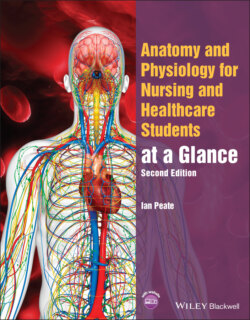Читать книгу Anatomy and Physiology for Nursing and Healthcare Students at a Glance - Ian Peate - Страница 15
Оглавление3 Homeostasis
Figure 3.1 Components of a negative feedback system.
Figure 3.2 Negative feedback – raised blood pressure.
Figure 3.3 Negative feedback – raised temperature.
Figure 3.4 Positive feedback of childbirth.
Homeostasis
Homeostasis is an important physiological concept and can be defined as the ability of the body or a cell to seek and maintain a condition of equilibrium within its internal environment when dealing with external changes. It is a state of equilibrium for the body. Homeostasis allows the organs of the body to function effectively in a broad range of conditions.
All the organs and organ systems of the human body work together in harmony and are closely regulated by the nervous and endocrine systems. The nervous system controls almost all body activities and the endocrine system secretes hormones that regulate these activities. Working together, the organ systems supply body cells with all the substances needed and also eliminate waste. They also keep temperature, pH, blood glucose and other conditions at just the right levels required to support life processes.
Temperature at 36.5 °C
Blood glucose – 4–8 mmol/L
pH of the blood – 7.4
Feedback mechanisms
There are a variety of feedback mechanisms used by the body to regulate internal systems. There are three fundamental elements associated with the feedback system: a receptor, a control centre and an effector (Figure 3.1). The effector may be a muscle, organs or another structure that receives messages indicating a reaction is required.
Receptor
The receptor senses changes in the internal environment, relaying information to the control centre. Specific nerve endings in the skin, for example, sense a change in temperature, detecting changes such as a sudden increase or fall in body temperature.
Control centre
The brain is the control centre, receiving information from the receptor and interpreting the information, and then sending information to the effector. The output could be nerve impulses or hormones or other chemical signals.
Effector
An effector is a body system, for example, the skin, blood vessels or the blood, that receives the information from the control centre, producing a response to the condition. For example, in the regulation of body temperature by our skin (if it drops below normal), the hypothalamus acts as the control centre, which receives input from the skin. The output from the control centre goes to the skeletal muscles via nerves to initiate shivering and this raises body temperature.
Negative feedback
Most body systems work on negative feedback. Negative feedback ensures that, in any control system, changes are reversed and then returned back to the set level. An example might be, if the blood pressure increases, then receptors in the carotid arteries detect this change in blood pressure and relay a message to the brain. The brain will cause the heart to beat more slowly and, by doing this, work towards decreasing the blood pressure. Decreasing heart rate has a negative effect on blood pressure (Figure 3.2). Another example of negative feedback is regulation of body temperature at a constant 37 °C. If we get too hot, blood vessels in the skin vasodilate and heat is lost and we cool down. If we get too cold, blood vessels in the skin vasoconstrict, we lose less heat and the body warms up. The negative feedback system therefore ensures that homeostasis is maintained (Figure 3.3).
Positive feedback
This is the mechanism used by the body to enhance an output needed to maintain homeostasis. Positive feedback mechanisms push levels out of normal ranges. While this process can be beneficial, it is rarely used by the body because of the risk of the increased stimuli becoming out of control.
An example of positive feedback is the release of oxytocin (a hormone) to increase and keep the contractions of childbirth happening as long as needed for the child’s birth. Contractions of the uterus are stimulated by oxytocin, produced in the pituitary gland in the brain, and the secretion of it is increased by positive feedback, increasing the strength of the contractions (Figure 3.4).
Another example of positive feedback occurs in lactation, during which the mother produces milk for her child. During pregnancy, levels of prolactin (a hormone) increase. Prolactin normally stimulates milk production but during pregnancy, progesterone inhibits milk production. At birth, when the placenta is released from the uterus, levels of progesterone drop and as a result, milk production flows. As the infant feeds, its suckling stimulates the breast, promoting further release of prolactin, producing even more. This positive feedback ensures the infant has sufficient milk during feeding. When the baby is weaned and is no longer breast feeding, stimulation stops, with prolactin in the mother’s blood returning to pre‐breastfeeding levels.
Clinical practice point
Respiratory system: a high concentration of carbon dioxide in the blood triggers faster breathing. The lungs exhale more frequently, which removes carbon dioxide from the body faster.
Excretory system: a low level of water in the blood triggers retention of water by the kidneys. The kidneys produce more concentrated urine, therefore less water is lost from the body.
Endocrine system: a high concentration of glucose in the blood triggers secretion of insulin by the pancreas. Insulin, a hormone, helps cells absorb glucose from the blood.
